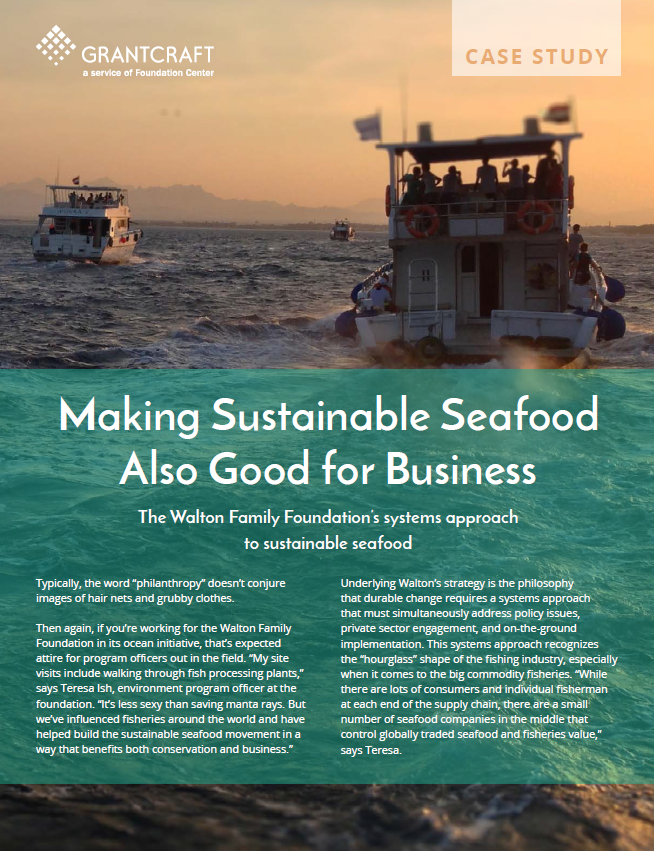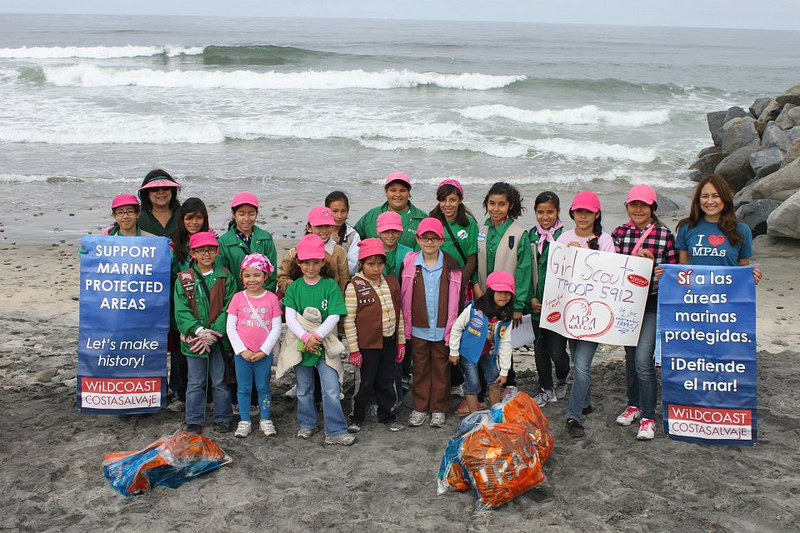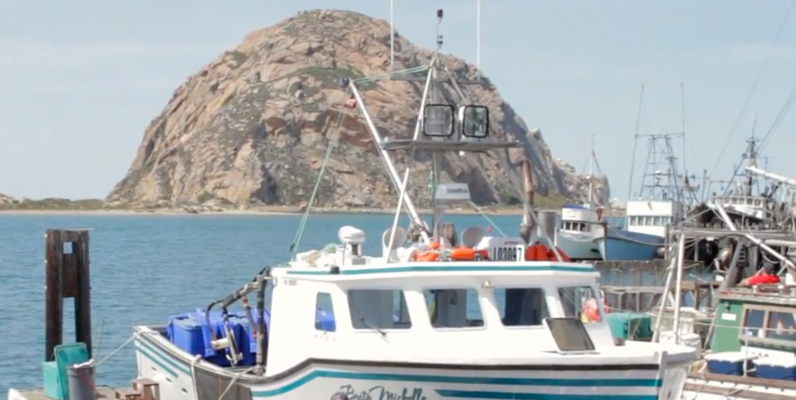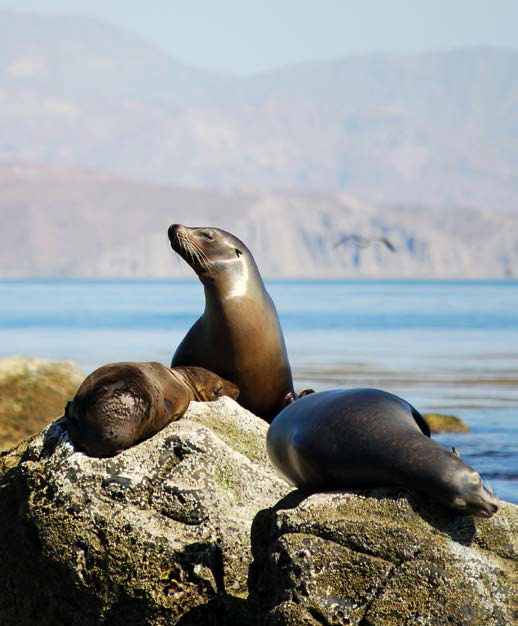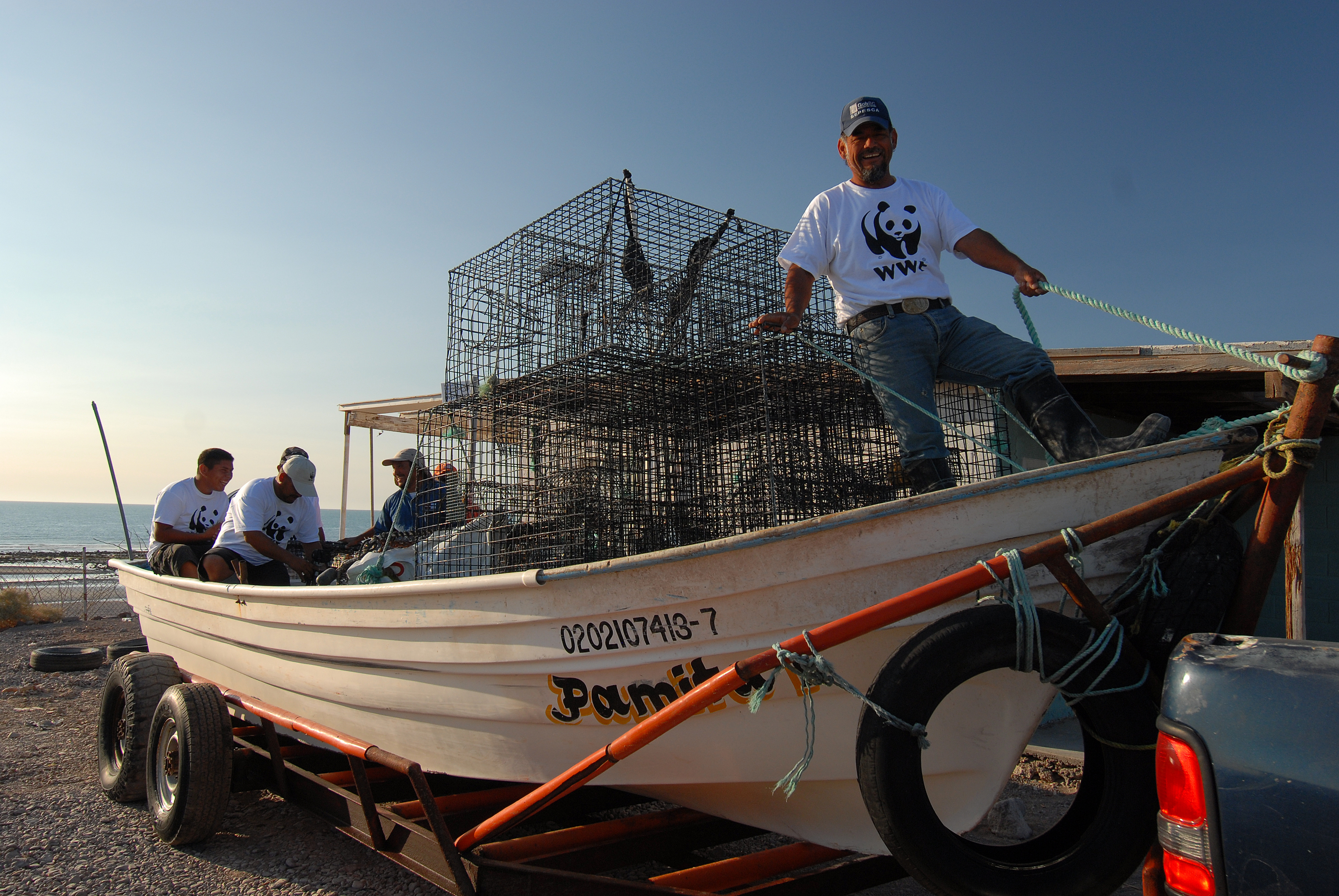Making Sustainable Seafood Also Good for Business The Walton Family Foundation’s systems approach to sustainable seafood
Typically, the word “philanthropy” doesn’t conjure images of hair nets and grubby clothes.
Then again, if you’re working for the Walton Family Foundation in its ocean initiative, that’s expected attire for program officers out in the field. “My site visits include walking through fish processing plants,” says Teresa Ish, environment program officer at the foundation. “It’s less sexy than saving manta rays. But we’ve influenced fisheries around the world and have helped build the sustainable seafood movement in a way that benefits both conservation and business.”
Underlying Walton’s strategy is the philosophy that durable change requires a systems approach that must simultaneously address policy issues, private sector engagement, and on-the-ground implementation. This systems approach recognizes the “hourglass” shape of the fishing industry, especially when it comes to the big commodity fisheries. “While there are lots of consumers and individual fisherman at each end of the supply chain, there are a small number of seafood companies in the middle that control globally traded seafood and fisheries value,” says Teresa.
While Walton has been involved in conservation work since 1993, it started funding seafood markets around 2008, about the time that efforts to work on the business of sustainable seafood heated up worldwide. At first, Walton focused largely on the big commodity fisheries producing major seafood products, including whitefish, salmon, shrimp, and crab. For the first seven years of Walton’s strategy, the foundation was trying to create a tipping point in the business practices of fisheries producing these seafood commodity products. “The idea was that if you get 75 percent of fisheries engaged, you tip the commodity,” says Teresa. “Then it would be too hard for the other 25 percent to get market access. And sustainability then isn’t ‘special,’ it’s just how you have to behave.”
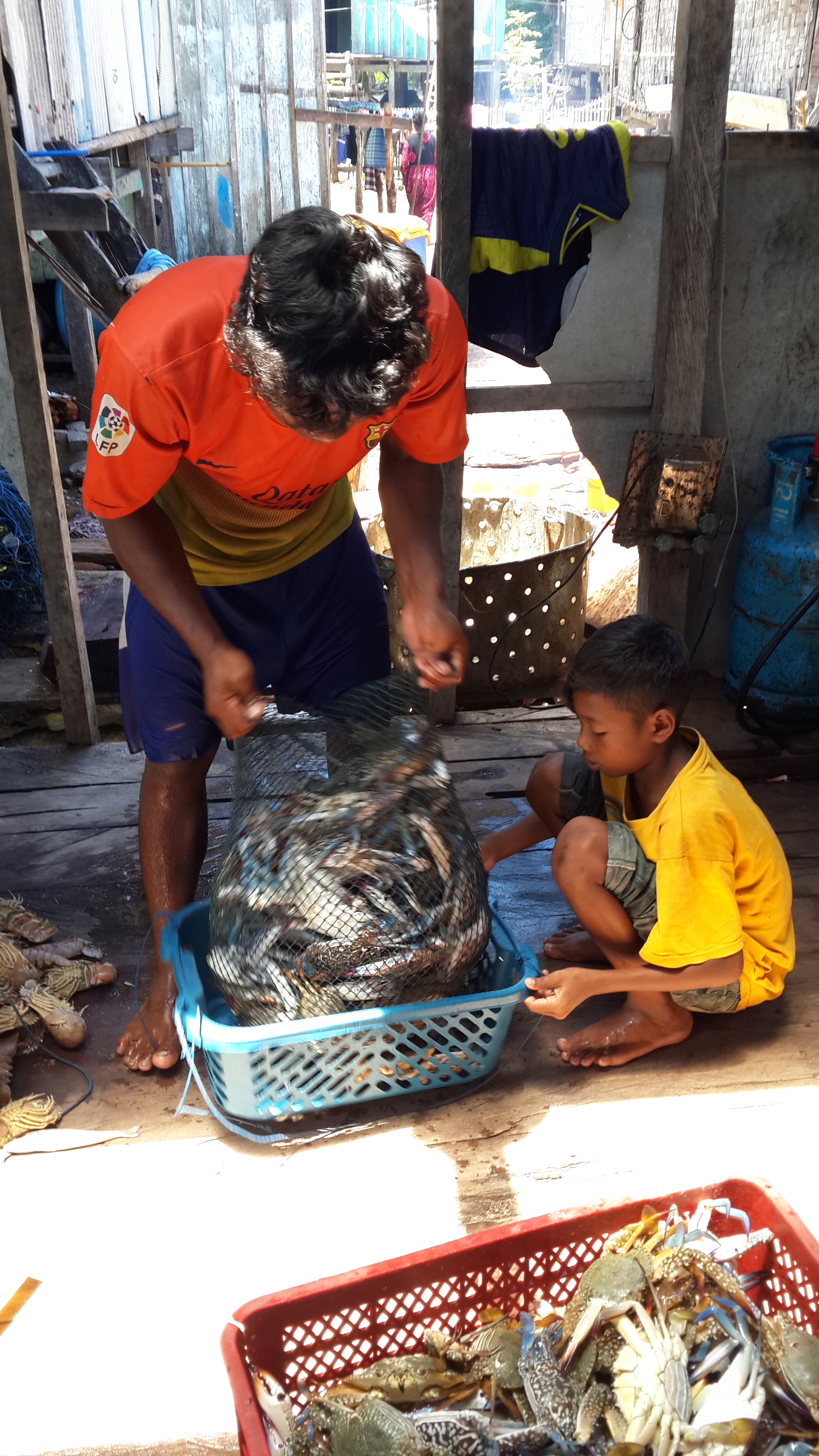 To create this kind of market pressure, the Walton Family Foundation sought on-the-ground partners with leverage. One partner is Sustainable Fisheries Partnership (SFP), a business-focused nonprofit that works with the seafood industry to deliver improvements in fishing and aquaculture. “We felt it was important to work with SFP because it holds partnerships with the biggest retailers in the U.S. and the U.K.,” says Teresa. SFP also helped design the fishery improvement project (FIP) model, which engages stakeholders influential to the seafood supply chain. Through multiple grants to SFP, Walton has helped build SFP’s FIP model into a portfolio of FIPs focused on different seafood products that could be tested and learned from.
To create this kind of market pressure, the Walton Family Foundation sought on-the-ground partners with leverage. One partner is Sustainable Fisheries Partnership (SFP), a business-focused nonprofit that works with the seafood industry to deliver improvements in fishing and aquaculture. “We felt it was important to work with SFP because it holds partnerships with the biggest retailers in the U.S. and the U.K.,” says Teresa. SFP also helped design the fishery improvement project (FIP) model, which engages stakeholders influential to the seafood supply chain. Through multiple grants to SFP, Walton has helped build SFP’s FIP model into a portfolio of FIPs focused on different seafood products that could be tested and learned from.
Some Walton grants to SFP have funded more global work, such as with whitefish fisheries. “Whitefish is what you find in fish patties,” says Teresa. “It’s one of the biggest seafood commodities.” Other grants to SFP have focused more in geographic locations, such as with shrimp fisheries in the Gulf of California. Walton funding has supported SFP’s capacity to share data that helps FIP stakeholders identify where problems lie in the supply chain so they can take action. For example, this might include providing information to buyers about whether a species is being harvested at a sustainable rate or whether it’s declining because of specific fishing practices. Walton has also supported SFP’s supply chain convening role, bringing together those most influential to a supply chain – from fishers to buyers – in roundtables to drive change that can make fishery practice more sustainable. Originally, Walton supported SFP's work more with fishermen, processors, and exporters. Now, Walton funds SFP to work with buyers and importers in parallel. “We learned while you can make progress with producers, if you don’t have buyers and importers at the table, and you hit a sticky problem that is against the interest of the producers, nothing happens.”
No FIP is exactly alike, since unique variables drive different markets in different geographies. That‘s why Walton has realized it has to be open to supporting different approaches, depending on the fishery sustainability challenges being addressed and the myriad of stakeholders. SFP, for example, uses a three-tiered approach in advocating for and mobilizing FIPs. It typically starts with Plan A: getting industry to self-start as many FIPs as possible. If that doesn’t happen, SFP goes to a Plan B: convening stakeholders to discuss problems and brainstorm solutions. Then, if interests still do not align or the fishery is not well-organized, SFP invokes Plan C: bringing in a field team of experts to help run the FIP or provide temporary technical support. The idea is to start collegially, by inviting and assisting approach that helps industry to be proactive and do it themselves. Then, if that doesn’t work, SFP intervenes, often behind the scenes, to drive change that leads to sustainable fishing policy and practices.
Here’s an example of how Walton has supported SFP’s capacity to push hard behind the scenes, engaging across the supply chain, from fishers to buyers and importers. Despite SFP’s work with the Mexican Pacific industrial trawl shrimp fishery, illegal shrimp fishing persisted for years in estuary and river mounts in the Gulf of California, areas where fishing is prohibited by Mexican fishing regulations. Initial efforts to convince fishers and Mexican authorities to address this issue failed. SFP received support from Walton to rent a satellite and take photographs on the opening day of the fishing season of all the protected areas up the coast. This gave a count of all the shrimp vessels fishing inside all the prohibited areas. SFP also rented an airplane for higher resolution imagery that could identify vessels, and a boat to station in a known violation hotspot to capture video of illegal fishing.
On the opening day alone, SFP detected over 300 boats – about one-third of the total fleet – fishing illegally. SFP put together this evidence in a package for the Mexican government, sharing that it wouldn’t release its findings to the media, but would talk with its importer partners. That meant that while SFP wasn’t going public with the information, it would use the data to appeal to those on the end of the supply chain responsible for bringing product to market in places like the U.S., where purchasing shrimp from fisheries undertaking illegal fishing practices would put them at risk of violating federal law that governs seafood market trade. SFP stressed how importing and buying illegally-caught shrimp could also create problems with major retailers, especially those with established sustainability requirements. SFP demonstrated that if all vessels complied, they would actually benefit by catching larger, and therefore more valuable, shrimp. This evidence-based but discrete approach resulted in positive dialogue with Mexican fishers and regulators. A cooperative solution was struck, backed up by large buyers and many importers contractually requiring suppliers of shrimp and shrimp products in the Mexican Pacific to certify compliance with all applicable domestic Mexican national laws governing sustainable shrimp fishing.
“We couldn’t have achieved these results without Walton support,” says Jim Cannon, chief executive officer of SFP. “Non-compliance with regulations and free riders are big problems in fishing. With Walton support, we were able to make the case effectively to leverage change.” This is precisely why Walton has supported SFP. “In our markets work, we have chosen partners with influence who can increase accountability,” says Teresa. “That’s what SFP has brought to the table time and again.”
Funder partnerships have also been critical to bringing about systems change in the seafood industry. As the Walton Family Foundation’s support for buyer partnerships and increasing FIPs has grown, so has its co-funding with other foundations, like the David and Lucile Packard Foundation, the Gordon and Betty Moore Foundation, and the Rockefeller Foundation. “The funder collaborations have allowed us to strive for accountability collectively alongside grantees,” says Teresa.
This collaborative and systemic approach to sustainable seafood has helped yield tremendous impacts all the way up the fishing industry supply chain. An example: “around 75 percent of whitefish fisheries are now at or close to being certified under Marine Stewardship Council (MSC) standard, which shows they support sustainable fishing,” says Jim. “That’s all of whitefish on the wild side of global production.” This represents substantial gains, considering the first whitefish fishery became MSC certified only in 2005. The impact on the whitefish supply chain extends well beyond fishery practice. Today, McDonalds serves MSC certified sustainable fish in all of its restaurants in Europe, Canada, and the U.S.
The next frontier for Walton and other foundations engaged in sustainable seafood grantmaking is beyond the big commodity fisheries. Walton’s focus has now shifted toward smaller scale fisheries, including fishing products important to consumers such as tuna and small pelagic fish like sardines, anchovies, herring, and mackerel. Walton’s systems approach is changing with these supply chains. “The challenge with these smaller fisheries and products is determining the scaling mechanism,” says Teresa. “If we go fishing community by fishing community, it will be hard to bring about sustainable change, especially in a way that local fishermen see how sustainable fishing benefits them and their communities.”
While Walton’s strategy has moved in the smaller scale fisheries direction, it is simultaneously reflecting back on systems it already helped build. “We want to understand what’s really changing on the ground,” says Teresa. “What’s happened with fisheries we’ve worked with? Have they really gotten better? Stalled out? What’s happened in different countries, on governance issues? How are companies changing in their approach to sustainability?” Answers to questions like these are being explored in an assessment commemorating the 20th anniversary of the sustainable seafood movement that Walton has co-commissioned with Packard. This assessment will reflect on what’s happened, as well as offer insights to inform future practice.
Unpacking the systems impact of funder and grantee sustainable seafood efforts will help reveal the complexity of actors and leverage points. For example, while industry leadership is sometimes key, it’s often layered on top of other types of activities, such as nonprofits talking to government, and grassroots organizers working with fishermen. “That’s where Walton has been so innovative,” says Jim. “They recognize the many moving parts that need to be considered when applying particular instruments of change and they’ve been very active in figuring out what other funders are doing and working with them on the markets approach.” Blake Lee-Harwood, strategy director at SFP, agrees. “Walton has understood the many interlocking elements required to get the job done and see lasting change. This can be especially hard in the world of oceans where there are lots of attractive things one could race to fund. But instead, Walton has brought a full and comprehensive understanding of how systems work makes sustainable change.”
So while hair nets and grubby clothes aren’t necessarily glamorous or easy to write about, Walton remains committed to its systems approach. “We pride ourselves on being systems funders,” says Teresa. A systems frame guides the foundation’s work in the sustainable seafood movement as well as other grantmaking areas, including education. “We’re okay with movement work taking time. We understand our investments made ten years ago are probably only now coming to fruition.” The challenge is getting other, particularly smaller funders to jump on board, since it can be hard to draw a direct line between foundation effort and results. “I’d love to see other funders in this space,” says Teresa. “It’s really cool work.”
This case study was developed as a companion piece to stories shared through Foundation Center’s Funding the Ocean project. Funding the Ocean is a dynamic hub to inform and inspire ocean conservation philanthropy around the world. It includes a mapping application, repository of reports and case studies, and a cloud-based platform for engagement.
